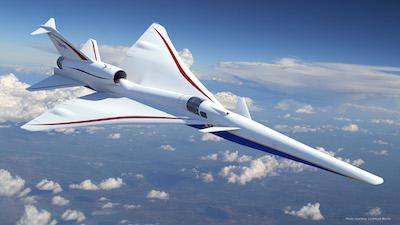Mon, Jan 21, 2019
Collins And Lockheed Martin To Jointly Develop Tailored Pro Line Fusion Avionics
In line with its vision to redefine aerospace, Collins Aerospace has been selected by Lockheed Martin to provide avionics for the new X-59 Quiet Supersonic Technology (QueSST) aircraft. The X-59 is being developed by Lockheed Martin for NASA to collect data that could make supersonic commercial travel over land possible through low sonic boom technology.

Collins will provide developmental engineering support to tailor its Pro Line Fusion avionics to the specific requirements of the X-59. By jointly developing software applications side-by-side, Lockheed Martin will receive an optimized solution which will also include Collins' award-winning touchscreen primary flight displays with tailored multi-function windows, head-up display (HUD) symbology, synthetic vision, ARC-210 communication radios, and a suite of navigation and surveillance equipment. Lockheed Martin will house a System Integration Lab for the Pro Line Fusion avionics at its facility in Palmdale, California.
In addition, Collins will provide a dual multi-spectral enhanced vision system (EVS-3600). In order to achieve supersonic speeds with a low sonic boom signature, the X-59 must have a long and slender shape. This shape also makes a forward-looking window impractical. The EVS-3600 will enable pilots to land in nearly all conditions using advanced visual sensors leveraging long wave, infrared technology.
"Our industry-leading avionics, combined with one of the most advanced EVS cameras in the market, will add to the safety and efficiency of this forward-leaning aircraft," said Dave Schreck, vice president and general manager for Military Avionics and Helicopters at Collins Aerospace. "We look forward to working with Lockheed Martin and NASA to play an integral role in making quiet supersonic travel over land possible for passengers."
The X-59, which is expected to take its first flight in 2021, is designed to create a sound about as loud as a car door closing, instead of a sonic boom. It will be used to collect data on the acceptability of the quiet sonic boom generated by the aircraft, helping NASA establish an acceptable commercial supersonic noise standard to overturn current regulations banning supersonic travel over land.
(Image provided with Rockwell Collins news release)
More News
Marker Beacon An electronic navigation facility transmitting a 75 MHz vertical fan or boneshaped radiation pattern. Marker beacons are identified by their modulation frequency and >[...]
“Aviation is an incredible tool for Samaritan’s Purse. After a disaster strikes, we want people to know why we are bringing life-saving supplies. We want them to know t>[...]
From 2024 (YouTube Edition): New Capabilities For Business Aviation CiES Corporation President Scott Philiben walked Aero-News Editor in Chief Jim Campbell through some of what set>[...]
Also: Duffy Predicts ‘Mass Chaos’, Modern Skies Coalition, More Impacts, Archer Buys Hawthorne With only a few months of preparation—and minimal outside media sup>[...]
The Experienced Pilot Chose To Operate In Instrument Meteorological Conditions Without An Instrument Flight Rules Clearance Analysis: The airplane was operated on a personal cross->[...]
 ANN's Daily Aero-Term (11.14.25): Marker Beacon
ANN's Daily Aero-Term (11.14.25): Marker Beacon Aero-News: Quote of the Day (11.14.25)
Aero-News: Quote of the Day (11.14.25) Classic Aero-TV: CiES All-Digital Fuel Senders
Classic Aero-TV: CiES All-Digital Fuel Senders Airborne 11.10.25: Affordable Expo Succeeds, Citation Ascend, Kenai Shuts Down
Airborne 11.10.25: Affordable Expo Succeeds, Citation Ascend, Kenai Shuts Down NTSB Final Report: Lancair 320
NTSB Final Report: Lancair 320



